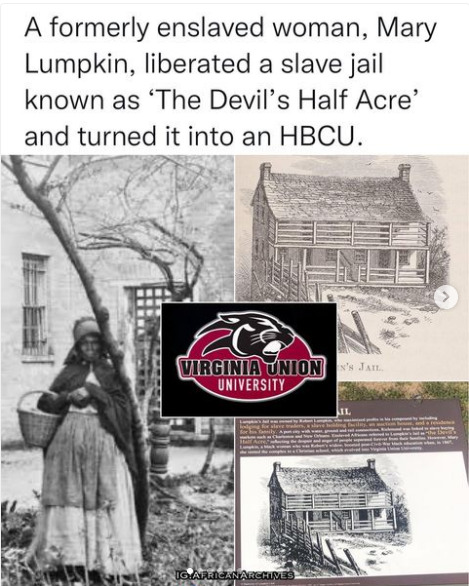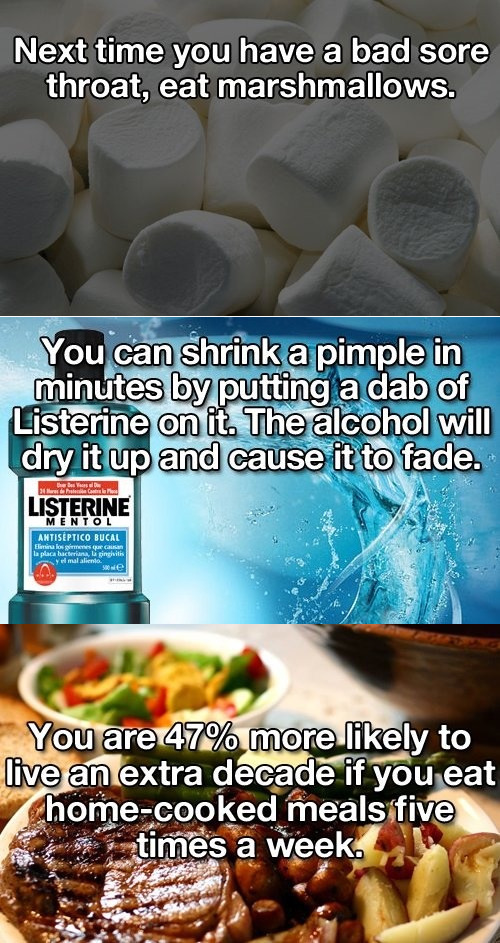Don't wanna be here? Send us removal request.
Text

Mary was sold to a man named Robert Lumpkin at the age of around 13 and was forced to bear children for him & help him run a slave jail in Richmond, Virginia. It was known as Lumpkin’s jail.
Slave jails were sites of confinement & torture for enslaved men, women and children who tried to escape from slavery to free states or who were waiting to be sold.
The Devil’s Half Acre was the largest antebellum slave-trading site outside of New Orleans. it was a holding pen, a punishment and “breaking” center for more than 300,000 enslaved men and women, Mary managed to educate her children and find a path to freedom, moving them and herself to the free state of Pennsylvania with Robert’s blessing prior to the Civil War. Mary had bargained for her children’s freedom. She reportedly told Robert that he could treat her however he wanted as long as their kids remained free. When Robert died in 1866, Mary and her children were living in Philadelphia, where they’d moved when the Civil War broke out to avoid being captured & sold into slavery. Robert had left the jail to Mary in a will so she inherited it, though she didn’t want anything to do with it.
With the help of a white Baptist missionary, she turned the place into a school. Black students began receiving education at the Richmond Theological School for Freedmen eventually becoming Virginia Union University.
It became the cornerstone for one of America’s historically Black colleges and universities (HBCU). Virginia Union University (VUU) is still in existence today.
African Archives Instagram
519 notes
·
View notes
Text
6K notes
·
View notes
Text
https://www.facebook.com/100041307528244/posts/pfbid032vJSYENenB8C1Q8QGT9hVNWQgUMR27bwa6ZYWiauht3tSEDAdSR7RMbDmuQTqQaUl/?sfnsn=mo&mibextid=6aamW6
3 notes
·
View notes
Text
https://m.facebook.com/story.php?story_fbid=pfbid023Zm5SVsJxgEovK3qePBPYn1ors77fWsRdWfMWwFYEJqg4RjPnXtopcrnAt7t6ij1l&id=100006056383033&sfnsn=mo&mibextid=YCRy0i
0 notes
Photo

Today in Hip Hop History:
Kanye West released his debut album College Dropout February 10, 2004
125 notes
·
View notes
Text
‘She’ll be back later’
written and imagined by Nasapussy
You knew I was a slut when you got with me.
You’ve always feared your own desires.
Your ego won't allow you to surrender peacefully.
What will your homeboys say?
It’s your own fault babe.
You like sluts.
In fact you love sluts.
But you want to control the uncontrollable.
Even though control of another being is an illusion.
What are you gonna do? Go find someone new to train up. I doubt it. I’ve seen your porn history, you’re only deceiving yourself. You want the ‘freak’ prepackaged.
****************************************************
To be continued
13 notes
·
View notes
Photo

How Long Does It Take To Build Muscle?
Building muscle mass takes consistent, specific work in the gym, decent nutrition, and healthy sleep habits. It’s a simple equation, really, if you’ve got the right strategies in place.
As far as I’m concerned, strength training, muscle-supporting nutrition, and quality sleep are lifelong necessities. If you’re revamping your entire routine to build muscle mass, though, you probably want to know how long it takes.
Here, I’ll break down how long it takes to build muscle mass—and what factors impact the fate of your gains.
The Muscle-Building Timeline
If you have the right strategies in place, you can see legitimate performance improvements in the gym in just eight weeks. In three to six months, you’ll see noticeable muscle gains.
In those first weeks, your nervous system adapts. From there, your muscles themselves start to truly increase in strength and size.
Read More: Are Abs Really Made In The Kitchen?
However, if you want to build noticeable muscle in just three months or so, consistency and effort are absolutely crucial. You can’t haphazardly hit the gym, stay up late watching Netflix, and ignore what you’re eating.
In fact, I consider consistent training and sleep, as well as proper nutrition, the three pillars of achieving sizable muscle gains—and fast.
How To Optimize Your Muscle-Building Timeline
Wondering how to best make your training, nutrition, and sleep work for your end game of building muscle? Let’s break down what you’ll need to do in each of these buckets to see major muscle gains in a few months.
Training Frequency And Building Muscle
New to resistance training? You may be able to get away with training each muscle group once per week in those first months in the gym.
As you become more experienced, though, you’ll require less recovery and need to increase training frequency. At that point, you’ll want to train each muscle group at least twice per week.
Nutrition—Namely Protein—And Building Muscle
As far as diet goes, focus on consuming sufficient protein every day. This helps you recover from exercise and supports overall muscle growth.
1.6 grams of protein per kilogram of body weight (or about 0.8 grams per pound of body weight) per day is enough to support muscle growth in most people. However, if you’re looking to maximize muscle growth, shoot for closer to 2.2 grams per kilogram of body weight (one gram per pound) instead.
Read More: 9 Easy Ways To Increase Your Protein Intake
Though consuming less protein won’t break you, you can certainly expect better long-term results if you get optimal protein in every day.
Sleep And Building Muscle
When it comes to optimizing body aesthetics, sleep can play just as big of a role as diet and exercise. In fact, getting poor sleep every night can impair muscle growth and recovery and make it more difficult to lose body fat.
To optimize sleep for fast gains, shoot for at least seven hours per night. Though eight to nine hours would be optimal for growth and recovery, I know spending that time in bed just isn’t always realistic.
The Bottom Line On Building Muscle
The rate at which you build muscle depends on a number of factors. However, you should start to see results within about three months or so of getting serious about packing on mass.
259 notes
·
View notes
Text



Seasoning, or The Seasoning, was the period of adjustment that slave traders and slaveholders subjected African slaves to following their arrival in the Americas. While modern scholarship has occasionally applied this term to the brief period of acclimatization undergone by European immigrants to the Americas, it most frequently and formally referred to the process undergone by enslaved people. Slave traders used "seasoning" in this colonial context to refer to the process of adjusting the enslaved Africans to the new climate, diet, geography, and ecology of the Americas.The term applied to both the physical acclimatization of the enslaved person to the environment and that person's adjustment to a new social environment, labor regime, and language.Slave traders and owners believed that, if a person survived this critical period of environmental seasoning, they were less likely to die and the psychological element would make them more easily controlled. This process took place immediately after the arrival of enslaved people during which their mortality rates were particularly high. These "new" or "saltwater" slaves were called "outlandish" on arrival. Those who survived this process became "seasoned", and typically commanded a higher price in the market. For example, in eighteenth century Brazil, the price differential between "new" and "seasoned" slaves was about fifteen percent

Regional Variance
"Atlantic Creoles" made up the first generations of enslaved people. Atlantic creoles were often mixed-race, integrated into and familiar with European society and gained freedom at higher rates prior to the eighteenth century. The first half of the 18th century saw a shift in Atlantic slavery where, as tobacco, sugar, and rice took root in the Caribbean and North American colonies, the enslaved population of the New World shifted from a "society with slaves" to a "slave society" with the predominance of “saltwater slavery” -- enslavement through the Atlantic slave trade. With the expansion of the slave trade in the mid-eighteenth century, the nature of slavery changed. Operating on a larger scale, slave traders transported enslaved Africans to various European colonies throughout the Americas (both before and after the decolonization of the Americas), systematizing both the voyage and the process of seasoning, though it varied locationally and temporally. While slave traders and owners practiced seasoning in both North and South America, it was not practiced consistently in the Souther Colonies where planters often forced "new" slaves to work immediately upon their arrival to the colonies.
Slave traders and slaveowners adopted the term "seasoning" during the transatlantic slave trade when newly arrived slaves died at high rates in the years following disembarkation. Death rates differed among regions in the Americas, though both the Middle Passage and the seasoning period were exceptionally deadly across the Americas. A "Dr. Collins" writing in 1803 attributed the high mortality rates to disease, change in climate, diet, labor, "severity," and suicide. In the Thirteen Colonies, death rates during seasoning were at an estimated 25 to 50 percent. In Cuba, deaths in a single year were between 7 and 12 percent while the mortality rate reached as high as 33 percent in Jamaica. In Brazil, an estimated 25 percent of enslaved people died during the seasoning process, where the law also required that slaves be baptized during their first year in Brazil

Diet
A contemporary observer noted that seasoning was a “training not only to hard work, but to scanty diet.” Slaveowners drastically limited the slaves' diets, both in breadth and depth, to the diet of the plantations, which was chiefly composed of maize, rice, or flour. Battered by this inadequate diet, enslaved people often suffered "dropsies" (edema) and "fluxes" (diarrhea), compounding their severe and widespread malnutrition.

Disease
Newly arrived slaves experienced high rates of disease and death during the seasoning process. During the Middle Passage, slave traders forced enslaved Africans to live in tight quarters without ventilation, sufficient food, or water, and with no opportunity for hygiene. In such conditions, enslaved people often contracted scurvy or amoebic dysentery; of which amoebic dysentery, or the "bloody flux," claimed the most lives. Once ashore, enslaved people lived in similarly appalling conditions to the Middle Passage. Underfed and exposed to a new ecology, enslaved people then had to battle the new climate and forced hard labor. Weakened by the voyage and immediate brutality of slavery, many enslaved people were killed by smallpox, measles, influenza, and unidentified diseased at high rates in the first several years after arrival.
Labor and Violence
Though it took many different forms, seasoning universally involved the further commodification of human beings and their preparation by enslavers for the marketplace and labor. Enslavers accomplished this preparation by treating their slaves harshly, subjecting them to a brutal regimen of training and violence. Lasting between one and three years, this process of adjustment was physically and psychologically taxing marked by brutality and coercion. Slaveholders resorted to force and violence in order to subdue the "saltwater" slaves and extract their labor. Enslavers regularly beat slaves, maimed them, and placed them in stocks or solitary confinement. In one particularly cruel practice, the slaveholder would whip a naked woman, often pregnant, and pour salt, pepper, or wax into her open wounds. In addition to violence, enslaved people had to adjust to hard labor over the seasoning period. In the Caribbean, newly arrived slaves were given baskets for fertilizing the sugar fields the week they arrived. This was the first step in the essential process of training the new arrivals in the technologies of sugar cultivation. Elsewhere, too, enslaved people were taught how to cultivate and process crops, often including the ones meant to sustain the enslaved population during the seasoning. Over the seasoning period, slaveowners wanted their slaves to acquire both knowledge of the labor and to become accustomed to the extreme workload. Training did not only take the form of labor. Enslaved people were also taught the language of the colony either by other slaves who had already undergone the seasoning process or by the white overseers of the plantation

Resistance
Though constantly threatened with beatings and further ill-treatment, enslaved people resisted their enslavement in the seasoning in several visible ways. Scholars have considered widespread suicide among newly enslaved people an act of resistance. Indeed, enslavers feared suicide alongside disease and contemporary manuals for the seasoning included recommendations for improving an enslaved person's "disposition" to best avoid suicide.Hunger plagued enslaved people during and after the seasoning and reports of food theft at any opportunity -- and the beatings from enslavers that followed such thefts -- were common. Still others refused to eat entirely and were similarly punished. Runaway attempts were common, though these recently enslaved arrivals rarely escaped successfully, as they had little familiarity with their surroundings and were isolated on the major plantations of the Americas
197 notes
·
View notes













